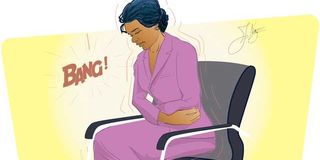
A woman with PGAD gets genital stimulation which is not accompanied by sexual desire.
“I have had 10 orgasms today, I am exhausted, I do not want anymore,” came the voice of the caller. I did not know the caller, so I could not make head or tail of what this was about.
“Maybe you need to mention this to your man?” I answered.
But my suggestion upset the caller. She emphasised that we must not drag a man into this. To avoid further misunderstanding, I requested the woman to come to the clinic, if anything, the conversation was agonising as it happens when phone lines choose to deliver some words and muffle others.
The moment she sat down in the consultation room, she closed her eyes and her body jerked as she pressed her thighs together. It took her five minutes to get back to her senses.
“So that is the 12th orgasm I am having today and I think it is because I have banged the door,” she explained. “They are doing repairs in the office and with each sound of a hammer leaves me with an orgasm.”
She looked anxious and harassed and complained of a headache. Jane had quite a unique condition. From the age of 13, she had been getting spontaneous genital stimulation, something similar to what a normal person would get at the height of foreplay. Initially, it would go for week,s and there would be no orgasm, but at 2,0 she started climaxing frequently.
Things got worse when she was on a motorbike or in a car on a rough road. She would suddenly get stimulated, culminating in orgasm. She could climax two to three times in one hour. The occurrences were getting more frequent as she grew. She was now 24, and there were days she could not just sustain normal life activities because the stimulation was too much.
“And you know with each orgasm, I am left too tired to concentrate on my work,” she explained.
Loud noises causing stimulation were a new development for her. This time round, renovations were being done in her office, and she had noted that with every loud bang she climaxed. She could not explain to her workmates what she was going through. She told them that she had unbearable tummy pains and was allowed to take the afternoon off to seek treatment.
Because of her condition, Jane had avoided getting involved with men. She feared that things could worsen if she got involved in romance. In fact she dreaded the thought of having sex, imagining that she could get multiple and painful bouts of orgasm that would leave her paralysed.
Jane was suffering from persistent genital arousal disorder (PGAD). The condition is generally taken to be rare, although it is suspected that many women could be having it but do not seek care due to fear and embarrassment. A recent Dutch study estimated that there could be 7,000 women with the disorder in the world. Many sexologists, however, feel that this could be a gross underestimate.
A woman with PGAD gets genital stimulation, which is not accompanied by sexual desire. There are no emotions or thoughts of sex attached. Further, the stimulation lasts for hours or even days and sometimes may ease off after orgasm happens. Orgasm causes relief, not pleasure, because it gives a break from the stimulation, although sometimes there may be pain accompanying the orgasm.
Stimulation may be aggravated by known or unknown factors. The aggravating factors are usually non-sexual in nature. For a number of victims, anything that causes vibration may lead to stimulation.
A most important characteristic of PGAD is that the woman suffers significant mental distress and may go into depression. In fact most of these women think of committing suicide, noting that people may never understand what they go through.
Currently, there is no definite known physiological cause of PGAD. Some theories point to abnormalities in the nerves around the genitals, others relate it to chemical changes in the body, while others point to abnormalities with blood vessels. The lack of knowledge around the physiological basis of the condition makes treatment difficult. In fact, the treatment protocol for now only aims at reducing the severity and frequency of symptoms rather than alleviating them.
“So you mean I will be like this forever,” Jane interjected.
“Not really, I expect improvement from the treatment plan.” We had agreed on counselling to alleviate mental stress, a cream to numb the genital area, avoidance of causative factors, and exercises of the pelvic muscles.
Six months later, Jane’s condition had significantly improved. She had gone for a month without orgasm. As she left the clinic after her review that day, it occurred to me that the world could be quite unfair.
There were loads of women seeking help because they had never had the experience of orgasm, yet here was Jane traumatised and going into depression due to unwelcome orgasms.





